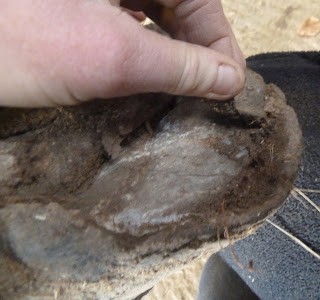I've read some quite out of date information online and I've also had several queries from owners. Altogether it sounds as if there is quite a bit of confusion out there so I thought a post about the differences, pros and cons might be useful. FWIW, this is not stuff that I've made up but it comes from either the NRC 2007 "bible" of equine nutrition or good UK farming practice (since the NRC isn't really au fait with a climate like Exmoor and lots of US peeps still view with incredulity a climate where you really, honestly, truly can't make good hay!).
Basics first - you can make the same grass into either hay or haylage. Which it becomes simply depends on the process, not what sort of grass it is. There is a common preconception that haylage is always "richer" than hay but this isn't actually true. It depends whether you are looking at protein, energy or sugar levels and it depends on what types of grasses your hay or haylage was made from.
So, here are the nuts and bolts.
Hay
- has a lower moisture content than haylage (should be 80% DM or higher);
- needs several days of continuously hot, dry weather to be properly made;
- MUST be correctly stored as humid, damp conditions can make it mouldy;
- has more spores/dust than haylage so should be soaked or steamed before feeding;
- can be high in sugar/starch (water soluble sugars can also be reduced by soaking);
- is lower in digestible energy and protein than haylage made from the same grass.
- should have a higher moisture content than hay but lower than silage; 40-65% DM is necessary for it to be suitable for horses;
- is partially dried (as if for hay) but is baled earlier and immediately wrapped. Good haylage can therefore be made where weather conditions are too precarious to make good hay (like Exmoor!);
- does not contain the level of spores/dust found in hay;
- has a lower level of non structural carbohydrate than hay made from the same grass; this is because the fermentation process converts sugars into fatty acids. Haylage need not be soaked because (a) high levels of water soluble sugars are not present and (b) once wet, it goes off and becomes unpalatable extremely quickly;
- provides more digestible energy and protein than hay made from the same grass;
- bales can be stored outside for months at a time but must NOT be punctured.
As always, your own horses are the best judges of what is "safe" forage but don't automatically discount haylage - it can be fantastic stuff ;-)

















































